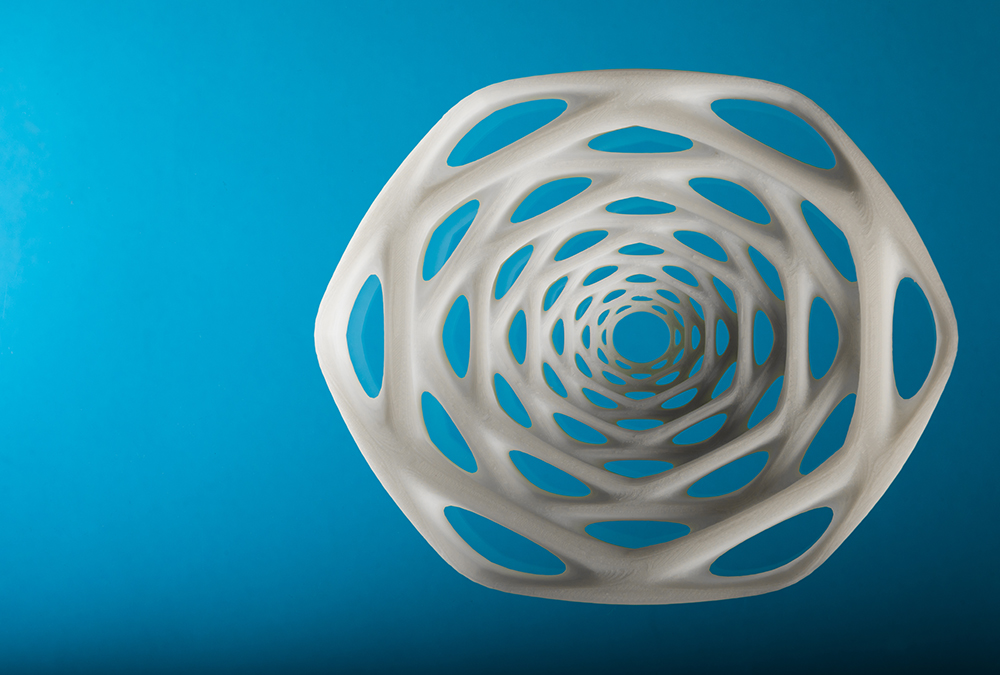“That’s something that you couldn’t even try without the computer. It wouldn’t be realistic,” said Jirka. “By the time you’d figured out how that worked, that’d be months of messing around with a piece of wax. You’d have to do hundreds of iterations. When you were done, you couldn’t go, ‘What if I twisted it 15 degrees?’ That would be impossible. That’s where I think [3D printing] is most effective, is in exploring what the possibilities are.”
 Jirka and Jones met at the Minneapolis College of Art and Design, where Jirka now teaches, and were married in 1980. They opened their first studio, St. Elmo’s Inc., in 1984, then moved and started Bohemiawerks in 2001. With St. Elmo’s, they worked a great deal in neon and other forms of lighting; they’ve always been interested in unconventional art forms.
Jirka and Jones met at the Minneapolis College of Art and Design, where Jirka now teaches, and were married in 1980. They opened their first studio, St. Elmo’s Inc., in 1984, then moved and started Bohemiawerks in 2001. With St. Elmo’s, they worked a great deal in neon and other forms of lighting; they’ve always been interested in unconventional art forms.
“I think it’s looking for new things, but not necessarily things that other people aren’t using, because we all use so much stuff,” said Jirka.
Jirka is also fond of crafts that involve working with his hands, such as wood and metal working, but he loves the opportunities that 3D printing opens up.
“There’s something really refreshing about going through that ideation process faster, and actually being able to get product out of it,” he said. “[The software] can both limit the process and it can expand the process—it depends how tenacious you are about exploring what’s possible.”
Jirka and Jones’ work ranges from small, jewelry-like pieces to giant installations mounted on skyscrapers. Scale isn’t an issue for them, and much of their work is interactive.
Some people like to divide artists into two camps: the traditionalists, who are suspicious of new methods of creation like 3D printing, and the new crop of artists for whom art and technology are inseparable. That’s often an unfair and untrue distinction. There are plenty of artists like Jirka and Jones, who have been working in the art world for decades but who are always on the lookout for new ways to create. Despite the possibilities that 3D printing presents, Jirka does admit that there are drawbacks to the technology, such as the potential for intellectual property theft – but he has a sense of humor about the potential for his art to be reproduced.
“My dream’s always been to have something turn up at Kmart,” he said. “I can go into Kmart and buy it out of a bin.”
Discuss this and other 3D printing topics at 3DPrintBoard.com or share your thoughts below.
[Source: The Growler]
Subscribe to Our Email Newsletter
Stay up-to-date on all the latest news from the 3D printing industry and receive information and offers from third party vendors.
Print Services
Upload your 3D Models and get them printed quickly and efficiently.
You May Also Like
Johns Hopkins University Researchers Develop HyFAM Technology
Two scientists from Johns Hopkins University, Nathan C. Brown and Jochen Mueller, have developed a hybrid manufacturing technology they call HyFam, or Hybrid Formative Additive Manufacturing. Their work on this technology...
3D Printing G-Code Gets an Upgrade: T-Code
Good old G-Code still manages many 3D printers, great and small. Just like the STL, it’s a standard that enables collaboration while also holding the additive manufacturing (AM) industry back....
AM Rewind: The Biggest News and Trends of 2024
After a sluggish 2023, driven by persistent inflation and geopolitical tensions, 2024 has seen some recovery. Economic growth climbed from about 2.8 percent in 2023 to a modest 3.2 percent...
Metal Wire 3D Printer OEM ValCUN Announces Plans for 2025 Expansion
ValCUN, a Belgian original equipment manufacturer (OEM) of wire-based metal additive manufacturing (AM) hardware, has announced that the company has entered the next phase of its growth trajectory, making key...



































